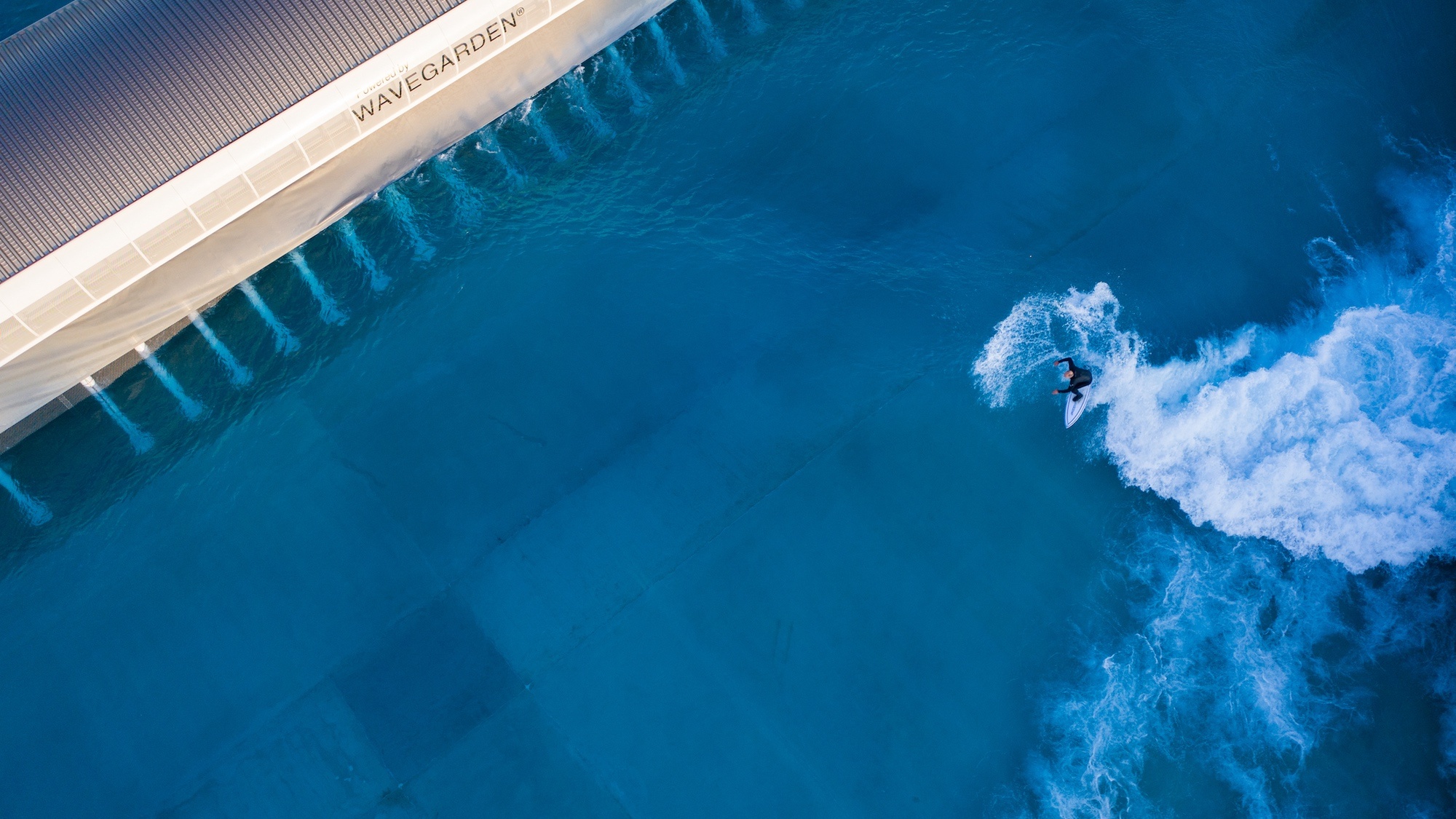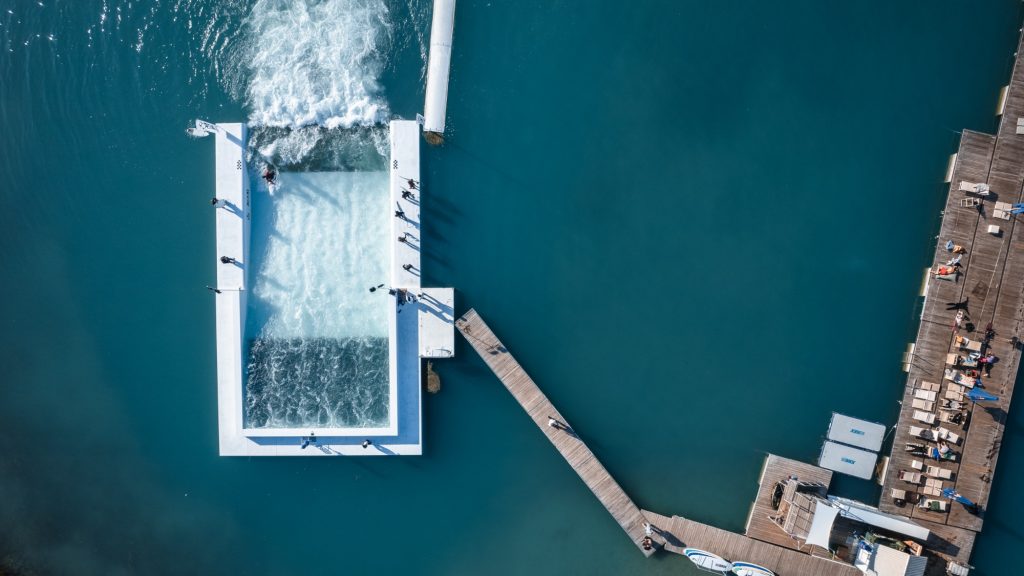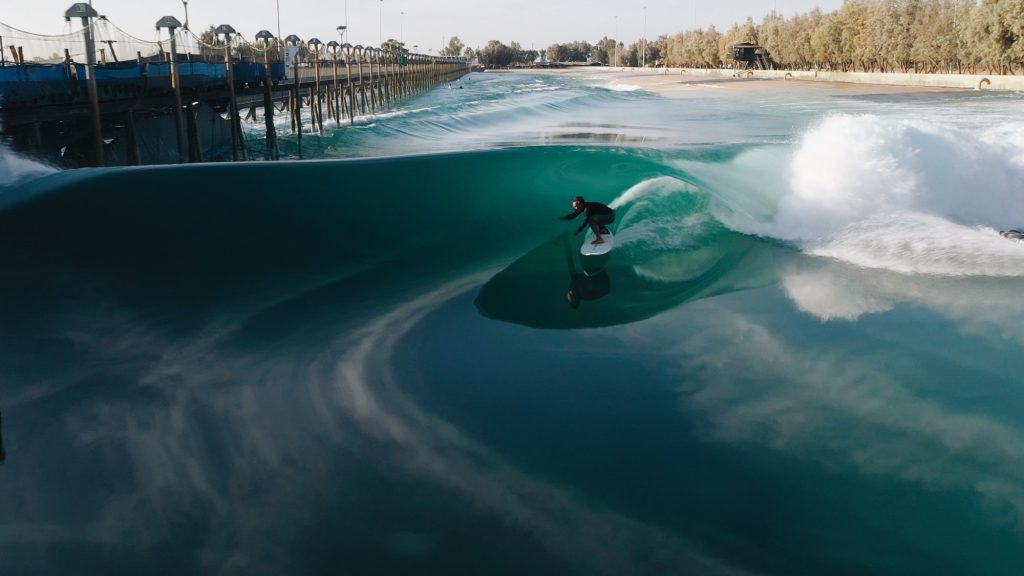Can I use my drone at a wave pool? Here’s what you need to know

Some of WavePoolMag’s favorite images to come across our inbox are drone-created. But can you, wave pool surfer and surf park enthusiast, merely show up for your session, drone in hand, and proceed to create a masterpiece? Yes and No. But, most likely no (and we’ll get to that). In this article, we’ll explore the why and the how of using your drone at a wave pool.
Which wave pools allow drone usage?
Every wave pool has a different policy on flying drones. We reached out to several surf parks to learn theirs. The short answer is that most don’t allow drones except under special circumstances, so check with your local wave tank before starting on your next YouTube masterpiece.
“Due to the number of drones that we remove from under our grates at the end of every season, last year we implemented an ‘only use drones during private sessions’ policy,” said Mike Schwaab of BSR Surf Resort. “Our policy seems to have worked a treat since we didn’t have to snag any out of our grates this offseason. But last year there were at least four down there!”
Some wave tanks require you to stay away from certain areas of the pool or to remain above a specified altitude. However, these are moot points if the wave pool is near real air traffic (you know, airplanes and such.)
“Due to our proximity to the airport, the use of drones at Urbnsurf requires special approvals from Melbourne Airport the Civil Aviation Safety Authority,” said wet blanket James Miles of Urbnsurf in Melbourne.
But you’re frothing to fly a drone and capture a new angle. Surely, Switzerland’s majestic Alaïa Bay is different… Unfortunately, it too is adjacent to a major airport and falls under similar restrictions.
“At Alaïa Bay, we have a slight issue regarding the use of drones,” said Vincent Riba. “Indeed we are located just 300 meters from the Airport of Sion. So the use of drones is very restricted and requires the authorization of the Airport Security Control.”
At the company’s Alaïa Bay Winter Cup, social media fans were treated to a host of images from up on high, spectacular on this occasion because the surrounding area was blanketed with fresh snow. In these cases the permits and hoop jumps are well worth it.
At The Wave in Bristol, the nearest airport is 17 miles away. Can we drone to our heart’s content there? No, but then, uh, maybe.
“We don’t allow members of the public to put up drones I’m afraid,” said Abby Richardson of The Wave. “We occasionally allow media/production companies to put up drones but these need to be agreed on a case-by-case basis. We make a decision depending on what / when they want to film, whether members of the public are in the lake, if it’s private hire etc.”
So what’s the best way to get a drone shot at a wave pool? Rent out the surf park and apply for all the necessary permits, if applicable.
Assuming you’ve rented out a pool like BSR for a private function then you’ll likely get the go-ahead. In celebration of your fete and soon-to-be award-winning drone footage we contacted Sarah Duke of Extreme Fliers, a site dedicated to all things drone, to get expert pilot advice. We discovered some interesting tidbits. For example, did you know that flying over a reflective surface, like a wave pool, adds to the craft’s chances of becoming destabilized?
Top image by Global Shots

Finding the Right Drone: Battery Life, Control Distance, Maneuverability
The first thing you need to do is make sure that you are getting the right drone. There are a few elements that you should be looking for. First, it’s important to make sure that you are getting something that comes with long battery life. The last thing you want is for the drone to run out of power when it’s over the water.
You’ll also need to think about the distance of the controller. You want something that you can control from a reasonable distance. It should be a minimum of 250 meters. Should you advance to shooting surf from the beach, you might want something that has an even longer range.
Third, it’s important to find something that you can maneuver easily. This will let you get out of trouble quickly if the waves prove to be bigger than you planned. Flying your drone is a skill that can be taught over time. This video embed below gives you some flying drills.
Finally, many drones come equipped with interesting technology. For example, you can get something that comes with follow-me mode. This is designed to track your movements and, depending on system, will work well with surfing.
Finding a Good Location to Film
You should consider the buildings in the area. Sometimes, the thick concrete and steel will stop the signal from going from the controller to the drone. This can lead to disaster. If the drone loses a signal, it might try to land back on the ground. This means it will end up going into the wave pool.
Get the Right Settings
Once you have found a suitable filming location, it’s time to start adjusting the settings on your drone. It should be noted that not all of these settings will be found on all drones. If your model doesn’t have them, don’t worry about it.
First, you need to look at the Vision Positioning System (VPS). This is an automated feature that tells the drone how high it is flying. The problem is that this technology was often built to be used over the ground. When you are flying over a reflective surface, like a wave pool, it can sometimes make your drone unstable.
It’s also best to make sure that the drone video is in automatic mode. Between flights, you can fiddle with the video settings, to make sure that you are getting the clearest video. But while the drone is in the air, you should leave them alone. You don’t have to risk becoming distracted and causing the device to crash.
Finally, before you start flying you should check your batteries and memory cards. If possible, have a few backups.
Find a Place to Launch and Land
You don’t need to get a specialized launchpad for your drone. But you do need to pick an area that will be dry. You should also try to pick something flat. If the wave pool is crowded, you will need to choose something that is out of the way.

Keep an Eye on the Drone
Now we are ready to take to the skies. Flying over the water is more challenging than flying over land. There are more hazards to watch out for. As an example, if you get too close to a large wave, it might cause spray which can disrupt the electronic systems on the drone. Another potential example is someone trying to splash it with water. Even birds can present a potential hazard.
Not all of this can be seen through the video camera. Because of this, it’s a good idea to keep the drone where you can see it. Remember to be vigilant and try to avoid as many of these hazards as possible. Try to keep at least 100 feet away from birds. If there are lots of seagulls in the area, it can be a good idea to put some protectors around the propellers.
In most cases, you should aim to be two meters above the water. Over time, you might be able to safely fly one meter from the water. But this is as low as you should go. Below this, there is a high risk of getting water into the drone.
Framing the Shot
Regardless of whether you are a professional or an amateur, we all want to get a good shot. The quality of the camera isn’t the only thing that will affect the way the footage looks. The angle and height that the drone is positioned on will also make a difference. How you opt to frame these pictures will depend on your style. But there are a few tips you can use. First, you should keep the subject in the middle of the frame. It’s also a good idea to shoot at a 45-degree angle. It’s also a good idea to fly around the subject, getting shots from all angles. If you want more tips, you should check out this article on framing drone shots.

Keeping the Drone Clean
The next thing that you need to do is make sure that you are keeping the drone clean. When you are flying around a wave pool like BSR, you might have to deal with sand. You can reduce the impact of this by putting a towel over the landing zone.
The good news is that it will be fairly simple to keep any debris from impacting the blade. All you need to do is use some compressed air. Spray this around any areas where the sand is trapped. You can also wipe the outside of the drone with a soft cloth. This will remove any spray from the salty water.
If the worst does happen, and the drone lands in the wave pool, it doesn’t have to be the end of the drone. First, you should remove the battery. Then, wash it off with fresh water. This guide walks you through the steps to save your drone after it lands in saltwater.
Conclusion
Flying over a wave pool is a great way of capturing some unique footage with your drone. Some people like to use this as a stepping stone to flying over the ocean. When you first start flying over the water, it’s common to be a little nervous. But, as long as you take some basic precautions, you shouldn’t have any issues. The more you practice, the more confident you will get. So, grab your drone and take to the skies.
While this can seem like a long checklist, it shouldn’t be impossible to find a drone that fits the bill. Most high-quality drones will be able to meet all these demands. Because of this, you should stick to something that comes from a well-known manufacturer. If you want to know what you should be looking for, check out this list of inexpensive drones.
Related Coverage
